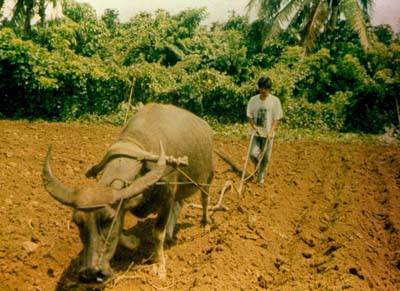|
Sweetpotato grows best and produces smooth, well-shaped storage roots in a
well-prepared soil. Good land or soil preparation involves removal or
incorporation of crop debris and any vegetation that may compete with the
sweetpotato crop, and deep manual or mechanical cultivation.
Cultivation aims to turn over the topsoil and loosen the compacted soil
below, to achieve a good tilth for forming the hills or ridges, and provide a
soft, uniform medium where storage root growth is not impeded. This can be
achieved by thorough plowing and harrowing done a number of times depending on
soil condition. Plant mulches, manures or other additives such as lime or
gypsum, that have been applied to the surface, are mixed into the soil for
greatest effect. Loosening up the soil increases the oxygen content, which
favours the development of microorganisms that decompose organic matter. Good
land cultivation also helps control weeds.
The use of heavy machinery, such as tractors, for soil preparation may
compact the sub-soil producing a hard pan or compaction layer. This problem is
greater on clay soils than on sandy soils. A hard pan can impede drainage,
causing waterlogging, poor development of beneficial organisms, and poor root
growth, which consequently leads to poor plant growth and poor quality storage
roots.
Soil should be cultivated when damp but not too wet. Cultivation of dry or
very wet soil can break up the soil structure, leading to poor drainage and
aeration, surface crusting, cracking allowing entry of weevils, and greater
susceptibility to erosion.
After cultivation, the land is usually formed into ridges. Mounds are
preferred by farmers working entirely with hand tools. In some areas, broad
raised beds are used. On deep, well-drained soil, planting may be done on flat
fields.
Ridges are oriented along contours on sloping land, to maximize rain
infiltration and minimize erosion. On flat irrigated land, ridges may be
oriented East-West for maximum light interception, or any direction for
convenience of furrow irrigation. Ridges are typically about 30-45 cm high, but
may be higher in wet areas to maximize soil drainage. They are usually between
90 and 120 cm apart.
Further cultivation after crop establishment may be undertaken to control
weeds, or to reform ridges (hill up) after fertilizer side dressing or to
prevent weevil infestation. However, disturbance of soil in the ridges should be
minimized to avoid root damage.
References
Rasco, E.T., Jr. and Amante, V. 2000. Sweetpotato in Tropical Asia. SAPPRAD-PCARRD.
230 p.
van de Fliert, E. and Braun, A. 1999. Farmer field school for integrated crop
management of sweetpotato. Field guides and technical
manual. International Potato Center. Lima, Peru. 266 p.
Contributed by:
Vilma Amante and
Jane
O'Sullivan |
Planting
material preparation
Planting
Soil
management
Water
management
Vine
lifting
Integrated
pest management
Harvesting
Postharvest
practices

Land
preparation using water buffalo and a plough in the Philippines (F. Villamayor). |

